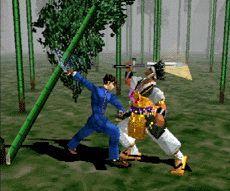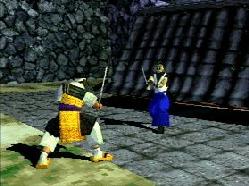Fight with honor… or just chop off his knees!
Bushido, or “the way of the warrior”, was a code of behavior followed by Japanese Samurai. It stressed honor above all else – death before dishonor. But the ways of Bushido can grow wily, young grasshopper.
Forget most of what you’ve learned; to understand the way of the warrior is not to master complex controls but to embrace the principle of honor before death.
Just when you thought game companies were losing touch with reality, along comes a fighting game that puts the emphasis on realism. Aside from a few minor problems, Bushido Blade cuts through the mire of 3D fighting with a revolutionary new system.
Bushido Blade does things differently than other fighting games. So many things, in fact, that to discuss them takes great patience, lest we lose our minds to the madness of invention.. To better understand the ways of this warrior, allow us to follow the hallowed and ancient 7 Lessons of Gaming.
Lesson 1: A game with no plot is like a duck with no shoes.
In other words, most fighting games barely need a plot. In the case of Bushido Blade, there is Story mode. This is where you fight as one of six characters against the other fighters, three sub-bosses and the final master. It follows a simple plot – Deep within the mountains of feudal Japan there is an ancient dojo called the Meikyokan, within which there exists a secret society of assassins called the Kage. Every Kage member pledges loyalty and secrecy, with the penalty being (drum roll) death. Of course, no Kage is allowed to leave…until one day one escapes. The other Kage assassins catch the fugitive at the Yin and Yang Castle (which sounds like a restaurant). You take over as that fugitive.
Lesson 2: Oregano is a spice, but variety is the spice of life.
Aside from Story mode, there are several other ways to play the game. There is the Training mode where you fight against another combatant with wooden practice weapons (that still manage to shed blood?). Then there is Slash mode, where you must chop your way through 100 ninjas and other samurai. Slash mode is actually better practice than Training mode, though it’s really hard to survive 100 matches without dying.
In a stroke of brilliance, someone thought about incorporating a first person element. This is called POV mode. You literally see through your characters eyes and fight in a Doom style perspective. This is a great addition; though not especially crisp, the graphics hold up well and you really feel a part of the action. The controls even toggle to meet your new needs (Up=Forward, Down =Back, etc.). Lastly, in Versus Mode you can kill your friends. With so many ways to play, it’s hard to get bored.
Lesson 3: A sword hurts. Especially when it hits your foot…
In most fighting games, the combatants can withstand incredible amounts of punishment. Even after 6 fireballs, 2 dragon punches, and one particularly nasty slice through the ribs, video game fighters manage to survive and can even win the fight. This is due to the existence of Ye Olde Miraculous Health Bar, a tried and true method of appropriating stamina. In a daring move, Bushido Blade forgoes the standard and opts for a more real and brutal approach. As in real life, a sword to the neck can be a severe problem. You can kill with one stab.. You can die by one slash.
Of course, there is some gradation to this. You can parry blows or just block them with luck, or even run away. In an even bolder stroke, you can suffer from injuries. If you get stabbed in the shin, you can’t stand up. But you’re still alive, so keep fighting on your knees. I applaud the designers for using their heads.
Furthermore, you can fight in one of three different stances, all of which lead to different moves and work better in different situations. The only problem here is that there just aren’t enough moves overall. I got a bit bored doing the same move over and over again (though I enjoyed the merciless slaughter).

Lesson 4: If all else fails, run like the wind.
When you think of a fighting game, you inevitably think of two guys squaring off in some sort of ring. Well, keep the two guys in your head but throw out the ring. For the first time ever, there exists no boundaries as to where you can fight. Sort of a cross between Tobal No.1 and Tekken 2, Bushido Blade allows you full freedom of movement. You are no longer restricted to fighting in a preset ‘ring.’ Rather, you are encouraged (often out of sheer necessity) to run around and come at your opponent from another angle. In Story mode, your object is to escape the castle. One way to do so is by finding the exit, which involves running from locale to locale. You can start in a Cherry Blossom grove, then run to a more comfortable wooden bridge, then seek safety in a Bamboo Thicket – all in the same fight.
Lesson 5: Live by the code, die by the code. Um, what’s the code again?
This is a game steeped in tradition, and there are even rules to killing with honor. Rather than tell you what these rules are, I’ll let you find out for yourself. This is both good and bad. For instance, I picked up the game and walloped the competition right off the bat – I made it to my character’s ending movie. A friend then did the same, only to be stopped about halfway in by a mysterious quote telling him that he broke the code. He was stopped again and again. We had no idea why, though we eventually pared it down to a few simple yet hard to ignore rules of combat. Again, innovative and bold.
Lesson 6: Perfection is in the mail.
There are unfortunately some glaring faults that hold this title back from the almost historical significance it could have achieved. The graphics are inconsistent. This isn’t really surprising, considering the freedom of movement. But they are still choppy and at times, terrible. Walls will disappear, only to suddenly pop up when you’re trying to run away from a madman with a rapier.
The one hit kill system , while certainly revolutionary, has its faults. It gets frustrating beating your opponent senseless, hacking way an arm and a leg, only to be caught in the jugular by a random swipe. Two player mode ends up becoming a 50-50 fight; I win half, you win half. In other words, it’s hard to get much better.
Lastly, there is the fun factor. Realism sometimes can’t beat just plain old arcade madness, and while all of the aforementioned innovations are breathtaking, I’d still rather play Soul Blade for the sheer fun of it all. At least there’s a little bit of blood, though.
Lesson 7: Summaries are for the weak, but I’m getting tired of writing.
Overall, Bushido Blade is the kind of game that comes along only once in a long while. By pushing the boundaries of gaming, it has secured a warm spot in my jaded reviewers heart. We love to see companies try new things; there are just so many new things going on here that it’s hard to want to go back. In a genre often lacking in creativity, Bushido Blademarks a turning point in game design. There is still a lot that can be done, but you should check this one out nonetheless
-
Revolutionary fighting system
-
Realism and innovation abound
-
Graphics could use an overhaul
-
Nice variety of play
-
Honorable, but not quite <a href="soul.htm">Soulful</a> enough







